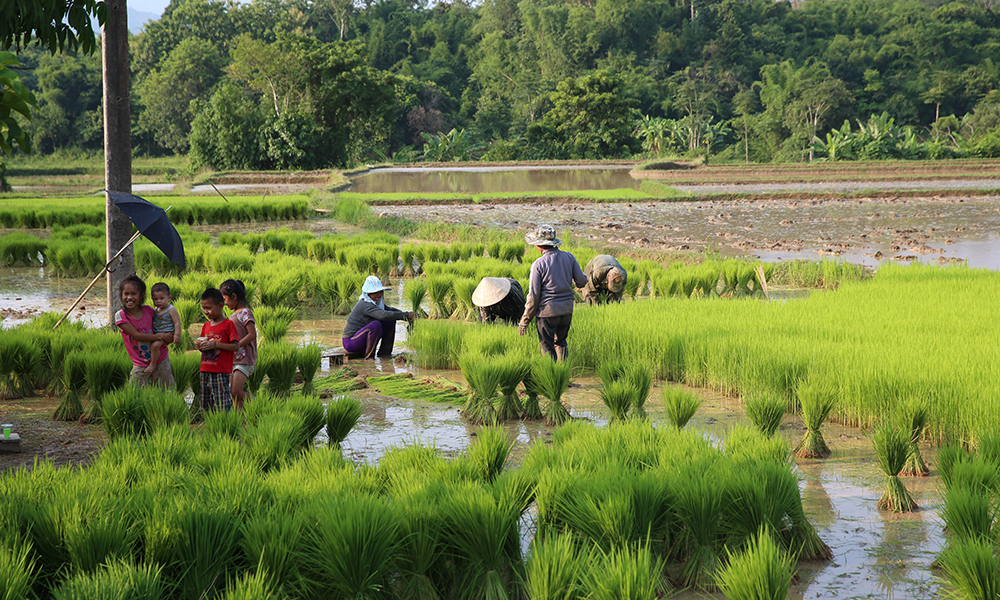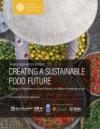Executive Summary (Synthesis)
{"Glossary":{"51":{"name":"agricultural tree crops","description":"Trees cultivated for their food, cultural, or economic values. These include oil palm, rubber, cocoa, cashew, mango, oranges (citrus), plantain, banana, and coconut.\r\n"},"141":{"name":"agroforestry","description":"A diversified set of agricultural or agropastoral production systems that integrate trees in the agricultural landscape.\r\n"},"101":{"name":"albedo","description":"The ability of surfaces to reflect sunlight.\u0026nbsp;Light-colored surfaces return a large part of the sunrays back to the atmosphere (high albedo). Dark surfaces absorb the rays from the sun (low albedo).\r\n"},"94":{"name":"biodiversity intactness","description":"The proportion and abundance of a location\u0027s original forest community (number of species and individuals) that remain.\u0026nbsp;\r\n"},"95":{"name":"biodiversity significance","description":"The importance of an area for the persistence of forest-dependent species based on range rarity.\r\n"},"142":{"name":"boundary plantings","description":"Trees planted along boundaries or property lines to mark them well.\r\n"},"98":{"name":"carbon dioxide equivalent (CO2e)","description":"Carbon dioxide equivalent (CO2e) is a measure used to aggregate emissions from various greenhouse gases (GHGs) on the basis of their 100-year global warming potentials by equating non-CO2 GHGs to the equivalent amount of CO2.\r\n"},"99":{"name":"CO2e","description":"Carbon dioxide equivalent (CO2e) is a measure used to aggregate emissions from various greenhouse gases (GHGs) on the basis of their 100-year global warming potentials by equating non-CO2 GHGs to the equivalent amount of CO2.\r\n"},"1":{"name":"deforestation","description":"The change from forest to another land cover or land use, such as forest to plantation or forest to urban area.\r\n"},"77":{"name":"deforested","description":"The change from forest to another land cover or land use, such as forest to plantation or forest to urban area.\r\n"},"76":{"name":"degradation","description":"The reduction in a forest\u2019s ability to perform ecosystem services, such as carbon storage and water regulation, due to natural and anthropogenic changes.\r\n"},"75":{"name":"degraded","description":"The reduction in a forest\u2019s ability to perform ecosystem services, such as carbon storage and water regulation, due to natural and anthropogenic changes.\r\n"},"79":{"name":"disturbances","description":"A discrete event that changes the structure of a forest ecosystem.\r\n"},"68":{"name":"disturbed","description":"A discrete event that changes the structure of a forest ecosystem.\r\n"},"65":{"name":"driver of tree cover loss","description":"The direct cause of forest disturbance.\r\n"},"70":{"name":"drivers of loss","description":"The direct cause of forest disturbance.\r\n"},"81":{"name":"drivers of tree cover loss","description":"The direct cause of forest disturbance.\r\n"},"102":{"name":"evapotranspiration","description":"When solar energy hitting a forest converts liquid water into water vapor (carrying energy as latent heat) through evaporation and transpiration.\r\n"},"2":{"name":"forest","description":"Forests include tree cover greater than 30 percent tree canopy density and greater than 5 meters in height as mapped at a 30-meter Landsat pixel scale.\r\n"},"3":{"name":"forest concession","description":"A legal agreement allowing an entity the right to manage a public forest for production purposes.\r\n"},"90":{"name":"forest concessions","description":"A legal agreement allowing an entity the right to manage a public forest for production purposes.\r\n"},"53":{"name":"forest degradation","description":"The reduction in a forest\u2019s ability to perform ecosystem services, such as carbon storage and water regulation, due to natural and anthropogenic changes.\r\n"},"54":{"name":"forest disturbance","description":"A discrete event that changes the structure of a forest ecosystem.\r\n"},"100":{"name":"forest disturbances","description":"A discrete event that changes the structure of a forest ecosystem.\r\n"},"5":{"name":"forest fragmentation","description":"The breaking of large, contiguous forests into smaller pieces, with other land cover types interspersed.\r\n"},"6":{"name":"forest management plan","description":"A plan that documents the stewardship and use of forests and other wooded land to meet environmental, economic, social, and cultural objectives. Such plans are typically implemented by companies in forest concessions.\r\n"},"62":{"name":"forests","description":"Forests include tree cover greater than 30 percent tree canopy density and greater than 5 meters in height as mapped at a 30-meter Landsat pixel scale.\r\n"},"69":{"name":"fragmentation","description":"The breaking of large, contiguous forests into smaller pieces, with other land cover types interspersed.\r\n"},"80":{"name":"fragmented","description":"The breaking of large, contiguous forests into smaller pieces, with other land cover types interspersed.\r\n"},"74":{"name":"gain","description":"The establishment of tree canopy in an area that previously had no tree cover. Tree cover gain may indicate a number of potential activities, including natural forest growth or the crop rotation cycle of tree plantations.\r\n"},"143":{"name":"global land squeeze","description":"Pressure on finite land resources to produce food, feed and fuel for a growing human population while also sustaining biodiversity and providing ecosystem services.\r\n"},"7":{"name":"hectare","description":"One hectare equals 100 square meters, 2.47 acres, or 0.01 square kilometers and is about the size of a rugby field. A football pitch is slightly smaller than a hectare (pitches are between 0.62 and 0.82 hectares).\r\n"},"66":{"name":"hectares","description":"One hectare equals 100 square meters, 2.47 acres, or 0.01 square kilometers and is about the size of a rugby field. A football pitch is slightly smaller than a hectare (pitches are between 0.62 and 0.82 hectares).\r\n"},"67":{"name":"intact","description":"A forest that contains no signs of human activity or habitat fragmentation as determined by remote sensing images and is large enough to maintain all native biological biodiversity.\r\n"},"78":{"name":"intact forest","description":"A forest that contains no signs of human activity or habitat fragmentation as determined by remote sensing images and is large enough to maintain all native biological biodiversity.\r\n"},"8":{"name":"intact forests","description":"A forest that contains no signs of human activity or habitat fragmentation as determined by remote sensing images and is large enough to maintain all native biological biodiversity.\r\n"},"55":{"name":"land and environmental defenders","description":"People who peacefully promote and protect rights related to land and\/or the environment.\r\n"},"9":{"name":"loss driver","description":"The direct cause of forest disturbance.\r\n"},"10":{"name":"low tree canopy density","description":"Less than 30 percent tree canopy density.\r\n"},"84":{"name":"managed forest concession","description":"Areas where governments have given rights to private companies to harvest timber and other wood products from natural forests on public lands.\r\n"},"83":{"name":"managed forest concession maps for nine countries","description":"Cameroon, Canada, Central African Republic, Democratic Republic of the Congo, Equatorial Guinea, Gabon, Indonesia, Liberia, and the Republic of the Congo\r\n"},"104":{"name":"managed natural forests","description":"Naturally regenerated forests with signs of management, including logging, clear cuts, etc.\r\n"},"91":{"name":"megacities","description":"A city with more than 10 million people.\r\n"},"57":{"name":"megacity","description":"A city with more than 10 million people."},"56":{"name":"mosaic restoration","description":"Restoration that integrates trees into mixed-use landscapes, such as agricultural lands and settlements, where trees can support people through improved water quality, increased soil fertility, and other ecosystem services. This type of restoration is more likely in deforested or degraded forest landscapes with moderate population density (10\u2013100 people per square kilometer). "},"86":{"name":"natural","description":"A forest that is grown without human intervention.\r\n"},"12":{"name":"natural forest","description":"A forest that is grown without human intervention.\r\n"},"63":{"name":"natural forests","description":"A forest that is grown without human intervention.\r\n"},"144":{"name":"open canopy systems","description":"Individual tree crowns that do not overlap to form a continuous canopy layer.\r\n"},"82":{"name":"persistent gain","description":"Forests that have experienced one gain event from 2001 to 2016.\r\n"},"13":{"name":"persistent loss and gain","description":"Forests that have experienced one loss or one gain event from 2001 to 2016."},"97":{"name":"plantation","description":"An area in which trees have been planted, generally for commercial purposes.\u0026nbsp;\r\n"},"93":{"name":"plantations","description":"An area in which trees have been planted, generally for commercial purposes.\u0026nbsp;\r\n"},"88":{"name":"planted","description":"A forest composed of trees that have been deliberately planted and\/or seeded by humans.\r\n"},"14":{"name":"planted forest","description":"Stand of planted trees \u2014 other than tree crops \u2014 grown for wood and wood fiber production or for ecosystem protection against wind and\/or soil erosion.\r\n"},"73":{"name":"planted forests","description":"Stand of planted trees \u2014 other than tree crops \u2014 grown for wood and wood fiber production or for ecosystem protection against wind and\/or soil erosion."},"148":{"name":"planted trees","description":"Stand of trees established through planting, including both planted forest and tree crops."},"149":{"name":"Planted trees","description":"Stand of trees established through planting, including both planted forest and tree crops."},"15":{"name":"primary forest","description":"Old-growth forests that are typically high in carbon stock and rich in biodiversity. The GFR uses a humid tropical primary rainforest data set, representing forests in the humid tropics that have not been cleared in recent years.\r\n"},"64":{"name":"primary forests","description":"Old-growth forests that are typically high in carbon stock and rich in biodiversity. The GFR uses a humid tropical primary rainforest data set, representing forests in the humid tropics that have not been cleared in recent years.\r\n"},"58":{"name":"production forest","description":"A forest where the primary management objective is to produce timber, pulp, fuelwood, and\/or nonwood forest products."},"89":{"name":"production forests","description":"A forest where the primary management objective is to produce timber, pulp, fuelwood, and\/or nonwood forest products.\r\n"},"87":{"name":"seminatural","description":"A managed forest modified by humans, which can have a different species composition from surrounding natural forests.\r\n"},"59":{"name":"seminatural forests","description":"A managed forest modified by humans, which can have a different species composition from surrounding natural forests. "},"96":{"name":"shifting agriculture","description":"Temporary loss or permanent deforestation due to small- and medium-scale agriculture.\r\n"},"103":{"name":"surface roughness","description":"Surface roughness of forests creates\u0026nbsp;turbulence that slows near-surface winds and cools the land as it lifts heat from low-albedo leaves and moisture from evapotranspiration high into the atmosphere and slows otherwise-drying winds. \r\n"},"17":{"name":"tree cover","description":"All vegetation greater than five meters in height and may take the form of natural forests or plantations across a range of canopy densities. Unless otherwise specified, the GFR uses greater than 30 percent tree canopy density for calculations.\r\n"},"71":{"name":"tree cover canopy density is low","description":"Less than 30 percent tree canopy density.\r\n"},"60":{"name":"tree cover gain","description":"The establishment of tree canopy in an area that previously had no tree cover. Tree cover gain may indicate a number of potential activities, including natural forest growth or the crop rotation cycle of tree plantations.\u0026nbsp;As such, tree cover gain does not equate to restoration.\r\n"},"18":{"name":"tree cover loss","description":"The removal or mortality of tree cover, which can be due to a variety of factors, including mechanical harvesting, fire, disease, or storm damage. As such, loss does not equate to deforestation.\r\n"},"150":{"name":"tree crops","description":"Stand of perennial trees that produce agricultural products, such as rubber, oil palm, coffee, coconut, cocoa and orchards."},"19":{"name":"tree plantation","description":"An agricultural plantation of fast-growing tree species on short rotations for the production of timber, pulp, or fruit.\r\n"},"72":{"name":"tree plantations","description":"An agricultural plantation of fast-growing tree species on short rotations for the production of timber, pulp, or fruit.\r\n"},"85":{"name":"trees outside forests","description":"Trees found in urban areas, alongside roads, or within agricultural land\u0026nbsp;are often referred to as Trees Outside Forests (TOF).\u202f\r\n"},"151":{"name":"unmanaged","description":"Naturally regenerated forests without any signs of management, including primary forest."},"105":{"name":"unmanaged natural forests","description":"Naturally regenerated forests without any signs of management, including primary forest.\r\n"}}}
Executive Summary (Synthesis)
-
As the global population grows from 7 billion in 2010 to a projected 9.8 billion in 2050, and incomes grow across the developing world, overall food demand is on course to increase by more than 50 percent, and demand for animal-based foods by nearly 70 percent. Yet today, hundreds of millions of people remain hungry, agriculture already uses almost half of the world’s vegetated land, and agriculture and related land-use change generate one-quarter of annual greenhouse gas (GHG) emissions.
This synthesis report proposes a menu of options that could allow the world to achieve a sustainable food future by meeting growing demands for food, avoiding deforestation, and reforesting or restoring abandoned and unproductive land—and in ways that help stabilize the climate, promote economic development, and reduce poverty.
Achieving these goals requires closing three great “gaps” by 2050:
- The food gap—the difference between the amount of food produced in 2010 and the amount necessary to meet likely demand in 2050. We estimate this gap to be 7,400 trillion calories, or 56 percent more crop calories than were produced in 2010.
- The land gap—the difference between global agricultural land area in 2010 and the area required in 2050 even if crop and pasture yields continue to grow at past rates. We estimate this gap to be 593 million hectares (Mha), an area nearly twice the size of India.
- The GHG mitigation gap—the difference between the annual GHG emissions likely from agriculture and land-use change in 2050, which we estimate to be 15 gigatons of carbon dioxide equivalent (Gt CO2e), and a target of 4 Gt that represents agriculture’s proportional contribution to holding global warming below 2°C above pre-industrial temperatures. We therefore estimate this gap to be 11 Gt. Holding warming below a 1.5°C increase would require meeting the 4 Gt target plus reforesting hundreds of millions of hectares of liberated agricultural land.
This report explores a 22-item “menu for a sustainable food future,” which is divided into five “courses” that together could close these gaps: (1) reduce growth in demand for food and agricultural products; (2) increase food production without expanding agricultural land; (3) exploit reduced demand on agricultural land to protect and restore forests, savannas, and peatlands; (4) increase fish supply through improved wild fisheries management and aquaculture; and (5) reduce greenhouse gas emissions from agricultural production.
On the one hand, the challenge of simultaneously closing these three gaps is harder than often recognized. Some prior analyses overestimate potential crop yield growth, underestimate or even ignore the challenge of pastureland expansion, and “double count” land by assuming that land is available for reforestation or bioenergy without accounting for the world’s growing need to produce more food, protect biodiversity, and maintain existing carbon storage. Significant progress in all 22 menu items is necessary to close the three gaps, requiring action by many millions of farmers, businesses, consumers, and all governments.
On the other hand, the scope of potential solutions is often underestimated. Prior analyses have generally not focused on the promising opportunities for technological innovation and have often underestimated the large social, economic, and environmental cobenefits. Our menu is detailed but several themes stand out:
- Raise productivity. Increased efficiency of natural resource use is the single most important step toward meeting both food production and environmental goals. This means increasing crop yields at higher than historical (linear) rates, and dramatically increasing output of milk and meat per hectare of pasture, per animal—particularly cattle—and per kilogram of fertilizer. If today’s levels of production efficiency were to remain constant through 2050, then feeding the planet would entail clearing most of the world’s remaining forests, wiping out thousands more species, and releasing enough GHG emissions to exceed the 1.5°C and 2°C warming targets enshrined in the Paris Agreement—even if emissions from all other human activities were entirely eliminated.
- Manage demand. Closing the food gap will be far more difficult if we cannot slow the rate of growth in demand. Slowing demand growth requires reducing food loss and waste, shifting the diets of high meat consumers toward plant-based foods, avoiding any further expansion of biofuel production, and improving women’s access to education and healthcare in Africa to accelerate voluntary reductions in fertility levels.
- Link agricultural intensification with natural ecosystems protection. Agricultural land area is not merely expanding but shifting from one region to another (e.g., from temperate areas to the tropics) and within regions. The resulting land-use changes increase GHG emissions and loss of biodiversity. To ensure that food production is increased through yield growth (intensification) and not expansion, and productivity gains do not encourage more shifting, governments must explicitly link efforts to boost crop and pasture yields with legal protection of forests, savannas, and peatlands from conversion to agriculture.
- Moderate ruminant meat consumption. Ruminant livestock (cattle, sheep, and goats) use two-thirds of global agricultural land and contribute roughly half of agriculture’s production-related emissions. Ruminant meat demand is projected to grow by 88 percent between 2010 and 2050. Yet, even in the United States, ruminant meats (mostly beef) provide only 3 percent of calories. Closing the land and GHG mitigation gaps requires that, by 2050, the 20 percent of the world’s population who would otherwise be high ruminant-meat consumers reduce their average consumption by 40 percent relative to their consumption in 2010.
- Target reforestation and peatland restoration. Rewetting lightly farmed, drained peatlands that occupy only around 0.3 percent of global agricultural lands provides a necessary and cost-effective step toward climate change mitigation, as does reforesting some marginal and hard-to-improve grazing land. Reforestation at a scale necessary to hold temperature rise below 1.5 degrees Celsius (i.e., hundreds of millions of hectares) is potentially achievable but only if the world succeeds in reducing projected growth in demand for resource-intensive agricultural products and boosting crop and livestock yields.
- Require production-related climate mitigation. Management measures exist to significantly reduce GHG emissions from agricultural production sources, particularly enteric fermentation by ruminants, manure, nitrogen fertilizers, and energy use. These measures require a variety of incentives and regulations, deployed at scale. Implementation will require far more detailed analysis and tracking of agricultural production systems within countries.
- Spur technological innovation. Fully closing the gaps requires many innovations. Fortunately, researchers have demonstrated good potential in every necessary area. Opportunities include crop traits or additives that reduce methane emissions from rice and cattle, improved fertilizer forms and crop properties that reduce nitrogen runoff, solar-based processes for making fertilizers, organic sprays that preserve fresh food for longer periods, and plant-based beef substitutes. A revolution in molecular biology opens up new opportunities for crop breeding. Progress at the necessary scale requires large increases in R&D funding, and flexible regulations that encourage private industry to develop and market new technologies.
Using a new model called GlobAgri-WRR, we estimate how three scenarios we call “Coordinated Effort,” “Highly Ambitious,” and “Breakthrough Technologies” can narrow and ultimately fully close our three gaps. Figure ES-1 illustrates how our five courses of action could feed the world and hold down global temperature rise. Although a formidable challenge, a sustainable food future is achievable if governments, the private sector, and civil society act quickly, creatively, and with conviction.
Figure ES-1
Ambitious efforts across all menu items will be necessary to feed 10 billion people while keeping global temperature rise well below 2 degrees Celsius

Notes
These charts show the most ambitious “Breakthrough Technologies” scenario. “Restore forests and peatlands” item includes full reforestation of at least 80 million hectares of liberated agricultural land, in order to reach the 4 Gt CO2e/year target by 2050 for limiting global temperature rise to 2°C. As an even more ambitious option, in order to limit warming to 1.5°C, full reforestation of at least 585 million hectares of liberated agricultural land could offset global agricultural production emissions for many years.
Sources
GlobAgri-WRR model.


